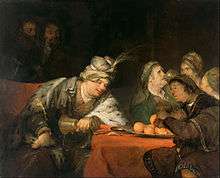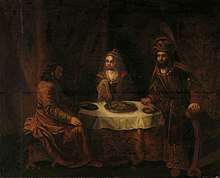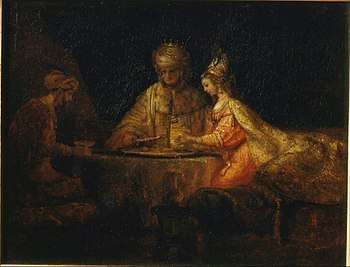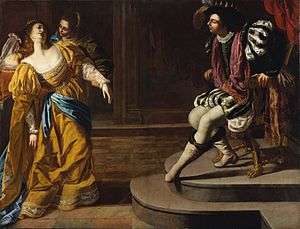Ahasuerus
Ahasuerus (/əˌhæzjuˈɪərəs/ ə-HAZ-ew-EER-əs; Hebrew: אֲחַשְׁוֵרוֹשׁ, Modern: ʼAḥašvērōš, Tiberian: ʼAẖašwērōš, commonly Achashverosh;[lower-alpha 1] Koine Greek: Ασουηρος, romanized: Asouēros, in the Septuagint; Latin: Assuerus in the Vulgate) is a name applied in the Hebrew Bible to three rulers and to a Babylonian official (or Median king) in the Book of Tobit.
%3B_Tintoretto%2C_Jacopo.jpg)
Etymology
The original name was Old Persian Xšaya.āršan (< xšaya 'king' + aršan 'male' > 'king of all male; Hero among Kings'). This became Babylonian Aḥšiyaršu (𒄴𒅆𒐊𒅈𒋗, aḫ-ši-ia-ar-šu), then becoming Akšiwaršu (𒀝𒅆𒄿𒈠𒅈𒍪, ak-ši-i-wa6-ar-šu), borrowed into Hebrew as אחשורוש ʼĂḥašəwērôš, and thence into Latin as Ahasuerus, the form traditionally used in English Bibles.[1][2]
The Persian name was independently rendered in Ancient Greek as Ξέρξης Xérxēs. Many newer English translations and paraphrases of the Bible[3] have used the name Xerxes.
Biblical references

Book of Esther
Ahasuerus is given as the name of a king, the husband of Esther, in the Book of Esther. He is said to have ruled "from India even unto Ethiopia, over an hundred and seven and twenty provinces" - that is, over the Achaemenid Empire.[4] There is no reference to known historical events in the story; the narrative of Esther was invented to provide an aetiology for Purim, and the name Ahasuerus is usually understood to refer to a fictionalized Xerxes I, who ruled the Achaemenid Empire between 486 and 465 BCE.[5][6] Persian kings did not marry outside a restricted number of Persian noble families and it is impossible that there was a Jewish queen Esther; in any case the historical Xerxes's queen was Amestris.[7] In the Septuagint, the Book of Esther refers to this king as 'Artaxerxes' (Ancient Greek: Αρταξέρξης).[8]
Historical identification

Numerous scholars have proposed theories as to who Ahasuerus represents. Most scholars generally identify him with Xerxes I, as did 19th-century Bible commentaries.[9] Three factors, among others, contribute to this identification:
- It is agreed the Hebrew 'Ahasuerus' descended from the Persian names for Xerxes I. Additionally, the form of the king's name written in Esther 10:1, ’aḥašērōš (Hebrew: אֲחַשֵׁרֹשׁ) bears much more resemblance to the original old Persian Xšayārša than the standard Hebrew form which does not omit the word's vavs.
- Historian Herodotus records Xerxes I having penchants for women and wine, as well as mentioning the king ruled from India to Ethiopia in a magnificent palace in Shusan (Susa), all of which the Book of Esther corroborates. Herodotus also mentions that Xerxes I sought comfort in his harem following his defeat at Salamis in the tenth month of his seventh year as king, which is strikingly similar to the date of Ahasuerus choosing beautiful women from his harem in the tenth month of his seventh year as king (Esther 2:16).
- Annals from the reign of Xerxes I mention an otherwise unattested official by the name of "Marduka", which some have proposed refers to Mordecai, as both are mentioned serving in the king's court.
The Septuagint, the Vulgate, the Midrash of Esther Rabbah, I, 3 and the Josippon identify the king as Artaxerxes I, and the historian Josephus relates that this was the name by which he was known to the Greeks.[10] The Ethiopic text calls him Arťeksis, usually the Ethiopic equivalent of Artaxerxes.
Book of Ezra

Ahasuerus is also given as the name of a King of Persia in the Book of Ezra.[11] Modern commentators associate him with Xerxes I who reigned from 486 BC until 465 BC. Other identifications have been made for Cambyses II[12] or with Bardiya (Greek Smerdis) who reigned (perhaps as an imposter) for seven months between Cambyses II and Darius I.[13]
Book of Daniel

Ahasuerus is given as the name of the father of Darius the Mede in the Book of Daniel.[14] Josephus names Astyages as the father of Darius the Mede, and the description of the latter as uncle and father-in-law of Cyrus by mediaeval Jewish commentators matches that of Cyaxares II, who is said to be the son of Astyages by Xenophon. Thus this Ahasuerus is commonly identified with Astyages. He is alternatively identified, together with the Ahasuerus of the Book of Tobit, as Cyaxares I, said to be the father of Astyages. Views differ on how to reconcile the sources in this case. One view is that the description of Ahasuerus as the "father" of Darius the Mede should be understood in the broader sense of "forebear" or "ancestor." Another view notes that on the Behistun Inscription, "Cyaxares" is a family name, and thus considers the description as literal, viewing Astyages as an intermediate ruler wrongly placed in the family line in the Greek sources.
Most scholars view Darius the Mede as a literary fiction, or possibly a conflation of Darius the Great with prophecies about the Medes.[15][16]
Book of Tobit
In some versions of the deuterocanonical Book of Tobit, Ahasuerus is given as the name of an associate of Nebuchadnezzar, who together with him, destroyed Nineveh just before Tobit's death.[17] A traditional Catholic view is that he is identical to the Ahasuerus of Daniel 9:1[18] In the Codex Sinaiticus Greek (LXX) edition, the two names in this verse appear instead as one name, Ahikar (also the name of another character in the story of Tobit). Other Septuagint texts have the name Achiachar. Western scholars have proposed that Achiachar is a variant form of the name "Cyaxares I of Media", who historically did destroy Nineveh, in 612 BC.
In legends
In some versions of the legend of the Wandering Jew, his true name is held to be Ahasuerus.[19] This is the name by which Immanuel Kant refers to the Wandering Jew in The Only Possible Argument in Support of a Demonstration of the Existence of God.[20]
Notes
- Cf. Old Persian: 𐎧𐏁𐎹𐎠𐎼𐏁𐎠𐎴, romanized: Xšaya.āršan; Persian: اخشورش, romanized: Axšoreš; New Persian: خشایار, romanized: Xašāyār; Ancient Greek: Ξέρξης, romanized: Xérxēs.
References
- KJV, NASB, Amplified Bible, ESV, 21st Century King James Version, ASV, Young's Literal Translation, Darby Translation, Holman Christian Standard Bible, etc.
- Nichol, F.D., Seventh-day Adventist Bible Commentary, Volume 3, Review and Herald Publishing Association, (Washington, D.C., 1954 edition), p.459, "Historical Setting"
- NIV, The Message, NLT, CEV, NCV, NIRV, TNIV, etc.
- Esther 1
- Browning, W. R. F., ed. (2009), "Ahasuerus", A Dictionary of the Bible (2nd ed.), Oxford University Press, doi:10.1093/acref/9780199543984.001.0001, ISBN 978-0-19-954398-4, retrieved 2020-04-17,
The story is fictitious and written to provide an account of the origin of the feast of Purim; the book contains no references to the known historical events of the reign of Xerxes.
- Tucker, Gene M. (2004) [1993], Metzger, Bruce M.; Coogan, Michael D. (eds.), "Esther, The Book of", The Oxford Companion to the Bible, Oxford University Press, doi:10.1093/acref/9780195046458.001.0001, ISBN 978-0-19-504645-8, retrieved 2020-04-17,
Although the details of its setting are entirely plausible and the story may even have some basis in actual events, in terms of literary genre the book is not history.
- Littman, Robert J. (1975). "The Religious Policy of Xerxes and the "Book of Esther"". The Jewish Quarterly Review. 65 (3): 146. doi:10.2307/1454354. JSTOR 1454354.
Xerxes could not have wed a Jewess because this was contrary to the practices of Persian monarchs who married only into one of the seven leading Persian families. History records that Xerxes was married to Amestris, not Vashti or Esther. There is no historical record of a personage known as Esther, or a queen called Vashti or a vizier Haman, or a high placed courtier Mordecai. Mordecai was said to have been among the exiles deported from Jerusalem by Nebuchadnezzar, but that deportation occurred 112 years before Xerxes became king.
- "Esther 1 And it came to pass in the days of Artaxerxes. This Artaxerxes held a hundred twenty-seven regions from India". studybible.info. Retrieved 2020-04-18.
- "The Religious Policy of Xerxes and the 'Book of Esther'", Littman, Robert J., The Jewish Quarterly Review, 65.3, January 1975, p.145–148.
- Ahasuerus at the JewishEncyclopedia.com
- Ezra 4:5-7
- Gill's Exposition of the Whole Bible, as quoted by Bible.cc/ezra/4-7.htm
- Clarke's Commentary on the Bible, as quoted by Bible.cc/ezra/4-7.htm
- Daniel 9:1
- Hill 2009, p. 114.
- House, Paul R. (20 November 2018). Daniel: An Introduction and Commentary. InterVarsity Press. p. 117. ISBN 978-0-8308-9100-9.
- Book of Tobit, 14:15.
- Maas, Anthony (1907). Assuerus. In The Catholic Encyclopedia. New York: Robert Appleton Company. Retrieved April 15, 2009 from New Advent
- Andrei Oişteanu, "The legend of the wandering Jew in Europe and Romania". Archived from the original on 2008-02-03. Retrieved 2008-03-12. Studia Hebraica.
- Kant, I. Der einzig mögliche Beweisgrund zu einer Demonstration des Daseins Gottes. 1763. AA 2:76
Sources

- Hill, Andrew E. (2009). "Daniel-Malachi". In Longman, Tremper; Garland, David E. (eds.). The Expositor's Bible Commentary. 8. Zondervan. ISBN 9780310590545.CS1 maint: ref=harv (link)
| Wikisource has the text of the 1911 Encyclopædia Britannica article Ahasuerus. |
External links
| Wikimedia Commons has media related to Ahasuerus. |
- McCullough, W. S. (1984). "Ahasureus". Encyclopaedia Iranica, Vol. I, Fasc. 6. pp. 634–635.CS1 maint: ref=harv (link)